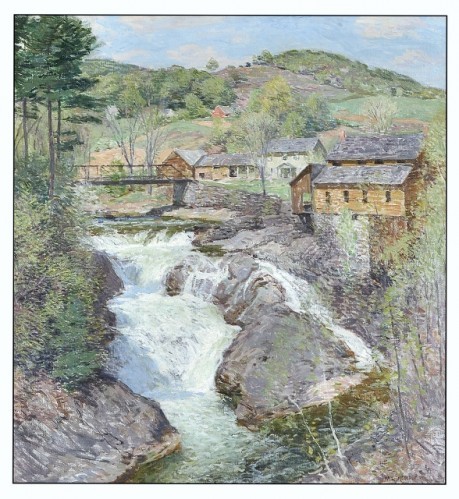
VERO BEACH — The Vero Beach Museum of Art’s executive director Lucinda H. Gedeon, Ph.D., collections committee, and board of trustees are pleased to announce the gift of a significant Willard Leroy Metcalf oil painting titled The Falls (1909-1910).
This recent Museum purchase was made possible with funds provided by the Mr. and Mrs. Robert L. Stott, Jr. Acquisition Fund and will add to the distinction and overall quality of the Museum’s permanent collection.
Willard Metcalf was a founding member of the group known as The Ten or Ten American Painters, formed in 1898. Other well-known members of the group were: Childe Hassam (1859-1935), Julian Alden Weir (1852-1919), Thomas Dewing (1851-1938), Edward Simmons (1852-1931), Joseph R. De Camp (1858-1923), Frank Benson (1862-1951), Robert Reid (1862-1929), and Edmund Tarbell (1862-1938). Upon Twachtman’s death, William Merritt Chase (1849-1916) joined the group.
Though most members of the group were influenced by French impressionism, they tended to work in a more poetic style that incorporated other stylistic traits.
Metcalf and Hassam were particularly close, often traveling and painting together in New England. Nevertheless, Metcalf, and not Hassam, captured the spirit of the region in his work.
In his 2003 essay for a comprehensive exhibition of Metcalf’s paintings, William H. Gerdts wrote that Metcalf “understood the [New England] landscape as distinctly American, as did no one else.”
Later in his career, Metcalf painted in and around Cornish, N.H., and across the Connecticut River in Vermont.
A recent article concerning the acquisition states: “It was undoubtedly in Vermont that Metcalf painted The Falls, based on sketches made at Brockways Mills. Located on the Williams River at the North end of the town of Rockingham, about five miles north of Bellows Falls, Vermont; Brockways Mills is less than 20 miles south of Cornish, just west of the confluence of the Williams and Connecticut Rivers. Although the falls are still recognizable, the mill itself has been supplanted by a hydroplant, the bridge has been replaced, and the hillsides are overgrown with trees.”
Born in Lowell, Mass., in 1858, Willard Metcalf studied with landscape painter George Loring Brown at the School of the Museum of Fine Arts, Boston. In 1883, he moved to Paris to pursue additional studies at the Academie Julian.
Metcalf was one of the first American artists to paint at Giverny, the village where Claude Monet lived and worked during the later years of his career.
After returning to America in 1888, Metcalf taught first at Art Students League and later at Cooper Union School of Art. After 1903, when he left teaching, he painted in Boothbay Harbor, Maine (1903-04); Old Lyme, Connecticut (1905-07); and northwestern Connecticut (1910-25), in addition to the area around Cornish, New Hampshire, mentioned above.
Metcalf’s paintings are included in the collections of the Butler Institute of American Art, the Art Institute of Chicago, the De Young Museum, the Denver Art Museum, the Boston Museum of Fine Arts, The Metropolitan Museum of Art, and many others.
The permanent collection of the Vero Beach Museum of Art is central to the Museum’s mission and features art from the early twentieth century to the present in a broad range of media. The collection presently includes 904 works of art and is currently concentrated on American and international art.
For further information visit the Museum’s web site at www.verobeachmuseum.org or call (772) 231-0707.



